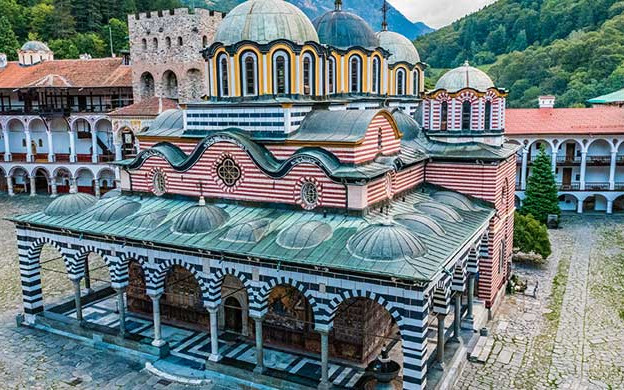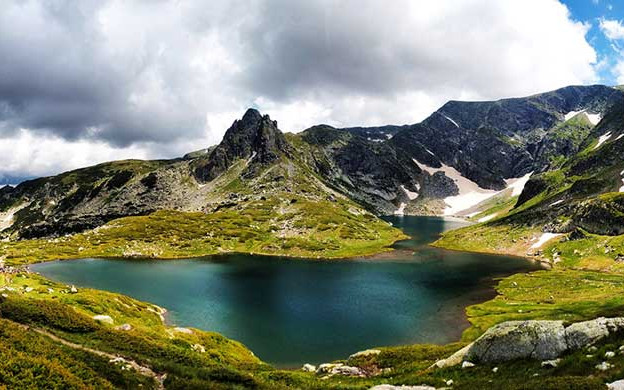Explorez la Bulgarie, joyau caché de l'Europe
La Bulgarie, un trésor inattendu à découvrir.
Venez explorer les richesses culturelles et naturelles bulgares.
Découvrir la Bulgarie : une aventure entre nature et histoire
Cet État-membre de l'Union européenne depuis 2007 mérite en effet le détour pour ses trésors culturels inscrits au patrimoine mondial de l'Unesco et la grande variété de ses paysages, du massif des Balkans aux belles plages de sable d'or au bord de la mer Noire.
La Bulgarie est le carrefour historique et géographique de l'Europe centrale où l'Occident et l'Orient mais aussi l'âme slave et la culture méditerranéenne se sont donné rendez-vous. On y croise ainsi en autotour ou en voyage organisé, en couple ou entre amis, plus d'une centaine de monastères orthodoxes dans des sites naturels souvent grandioses comme dans les monts Rila, des cités antiques thraces et romaines précieusement conservées comme à Abritus et même des églises rupestres creusées dans la roche à Ivanovo.
Partir en Bulgarie, c'est aussi plonger aux sources du thermalisme en couple ou entre amis dans des centaines de sources naturelles et une multitude de stations thermales, sur les rivages de la mer Noire comme en montagne. Le tourisme vert est d'ailleurs un atout majeur pour venir randonner ici entre forêts, massifs, lacs et vallées dans une dizaine de parcs nationaux. Et l'hiver, c'est joli aussi notamment grâce aux trois stations de ski locales.
Une destination méconnue à découvrir
Mis à part le yaourt, sa capitale Sofia ou une équipe de football qui avait fait pleurer les supporteurs des Bleus dans les années 1990, la Bulgarie ne vous évoque sans doute pas grand-chose. Pourtant, une dizaine de millions de touristes étrangers vient chaque année en voyage en Bulgarie, en provenance de Russie, d'Allemagne et d'Angleterre.

Les incontournables à visiter
Blottie dans une large baie de la mer Noire, la cité de Baltchik est bâtie au pied de hautes collines dans un décor de roche calcaire au blanc scintillant. Ce cadre magique est riche en curiosités touristiques, avec plusieurs stations balnéaires renommées à proximité.
La cathédrale-monument Alexandre Nevski à Sofia, avec la Basilique Sainte-Sophie, est l'autre symbole de la capitale bulgare. Elle est la plus vaste cathédrale des Balkans et l'une des plus importantes du monde orthodoxe, attirant le regard par sa décoration intérieure riche et ses splendides dômes dorés.
Veliko Tarnovo, l'ancienne capitale royale, propose au nord du pays un étagement unique de maisons disposées en amphithéâtre autour de la rivière Yantra et de ses méandres.
Le monastère de Rila, toujours habité par des moines orthodoxes après dix siècles, est le plus célèbre de Bulgarie. Ce site mêle spiritualité et splendeurs architecturales de la Renaissance bulgare du XIXe siècle dans un cadre sauvage et envoûtant, classé au patrimoine mondial par l'Unesco.

Découvrez la Bulgarie autrement
Le plus vaste parc naturel du pays s’étend à 100 km au sud de Sofia. C'est un territoire de forêts et de montagnes, dont le mont Moussala, point culminant de Bulgarie à 2925 m. Il est parcouru par de grandes rivières et parsemé de plus d’une centaine de lacs, notamment les sept de la montagne de Rila à plus de 2 000 m d’altitude.
Dans le massif de Rila se trouve également la plus grande et la plus ancienne station de sports d’hiver du pays. Perchée à 1300 m, Borovets a été inaugurée en 1896 par le prince Ferdinand Ier de Bulgarie. Malgré son âge, c’est une station moderne et haut de gamme.
Sozopol est l’une des plus anciennes villes bulgares, fondée par les Grecs au Ve siècle avant J.C. Située sur une presqu’île rocheuse au bord de la mer Noire, elle offre à ses nombreux visiteurs estivaux un joli dédale de ruelles pavées dans son cœur historique.
La "Ville aux 7 collines", Plovdiv, a été moins touchée par l’urbanisme soviétique que Sofia. Capitale européenne de la culture en 2019, elle concentre dans son cœur historique un nombre impressionnant de ruines antiques, dont un amphithéâtre et un stade romains. Ses pavés et ses maisons colorées valent aussi le coup d’œil.
Une destination aux charmes naturels variés
Le climat de la Bulgarie est tempéré, avec un mélange d'influences continentales et méditerranéennes. Pendant des décennies, les Nordiques du bloc de l'Est y trouvaient leur Côte d'Azur. Cela signifie qu'il y a peu de mois désagréables pour le tourisme en plein air. Les beaux jours sont fréquents tout au long de l'année. La culture des cafés et des terrasses est caractéristique du pays, tout comme les balades vespérales sur les avenues piétonnes, les promenades en bord de mer ou dans les parcs. Entre mars et octobre, la flânerie du soir est une activité nationale en Bulgarie. Les conditions naturelles pour pratiquer des sports de plein air sont excellentes toute l'année : ski, surf des neiges et raquettes en hiver, baignade, planche à voile, navigation, plongée, trekking, randonnée, escalade et alpinisme en été. De plus, ce bon climat vous permettra de déguster toute l'année des fruits et légumes d'excellente qualité aux saveurs rustiques. Sans oublier le vin...
Découvrez une nature spectaculaire
La nature bulgare est belle et variée. Des paysages de basse et moyenne montagne, des plaines, vallées, gorges et alpages, des piémonts viticoles, falaises, plages, baies et lagons composent de somptueux panoramas. Le Sud-Ouest de la Bulgarie est la région la plus spectaculaire pour les amateurs de montagne. Il est couvert de massifs de moyenne et haute montagne, avec des paysages entre le Massif central et les Alpes. Ces montagnes jeunes, similaires aux Alpes, culminent à près de 3 000 mètres.
Cet ensemble inclut les massifs du Vitocha, Rila, Pirin et Rhodopes. Le Grand Balkan, ou Stara Planina, est un autre massif fascinant. Ces régions forment un paradis pour les amoureux de la montagne et de la nature, propices à la randonnée et aux sports de montagne. La faune y est abondante avec ours, lynx et loups. La Bulgarie possède une superbe diversité d'écosystèmes : mer Noire, cours du Danube et réserves ornithologiques exceptionnelles. Pour sa taille, elle offre une richesse écologique incomparable.
The Land of Thermal Baths
Avec ses presque 600 sources d'eau minérale aux vertus curatives, le territoire bulgare était déjà reconnu dans l'Antiquité comme une destination thermale prisée. Les Thraces, puis les Romains, ont bâti des villes et des bains publics autour de ces sources, situées aux pieds des montagnes et le long de la côte de la mer Noire. L'empereur Septime Sévère et Julia Domna ont prolongé leur séjour pour profiter des eaux thermales de Sofia. Les Romains ont construit à Varna les plus grands thermes de la péninsule balkanique.
Aujourd'hui, ces eaux présentent des compositions chimiques variées avec un taux de minéralisation important et constant. La combinaison d'un climat doux et des vertus curatives attire de nombreux visiteurs. Plusieurs stations bien équipées offrent un large choix de traitements. Parmi les sites notables figurent un geyser à Saparéva Banya, ainsi que les villes thermales de Velingrad, Sandanski, Devin et Hissarya.
A website by
Customize your trips with Quotatrip and receive tailor-made offers directly in your inbox.
Copyright 2025 © Quotatrip.